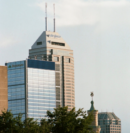Featured Projects and Maps
Empowering Indiana Communities with Evictions & Foreclosure Data
The Polis Center developed a new statewide tool to help users better understand trends and relationships between evictions and societal factors. The goal of the tool is to raise awareness of evictions in Indiana and provide a resource to empower communities to instill change. The tool debuted at the Dec 7 SAVI Talks event.

How is Indianapolis Doing?
This initiative features bimonthly e-newsletter updates on how the Indianapolis metro area is recovering and emerging from the COVID-19 pandemic on some of the most pressing and challenging issues in our community. Subscribe to our bimonthly newsletter to learn more about Indy's economic recovery, housing, gas prices, and more!



